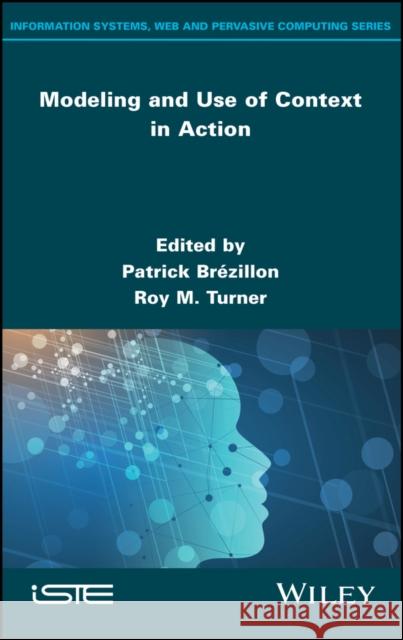Modeling and Use of Context in Action » książka



Modeling and Use of Context in Action
ISBN-13: 9781786308290 / Angielski / Twarda / 2022 / 320 str.
Modeling and Use of Context in Action
ISBN-13: 9781786308290 / Angielski / Twarda / 2022 / 320 str.
(netto: 643,50 VAT: 5%)
Rabat: -1%
Najniższa cena z 30 dni: 662,81 zł
1-3 dzień roboczy
Darmowa dostawa!
Preface xiPatrick Brézillon and Roy M. TurnerIntroduction xxiPatrick Brézillon and Roy M. TurnerChapter 1 Pragmatic Research on Context Modeling and Use 1Patrick Brézillon and Roy M. Turner1.1 Introduction 11.2 Pragmatic research on context 21.3 Role of context in AI systems 31.3.1 Data, information and knowledge 31.3.2 Contextual knowledge 61.4 Three examples of pragmatic research on context 81.4.1 Introduction 81.4.2 Contextual graphs (CxGs) 91.4.3 Context-based reasoning (CxBR) 111.4.4 Context-mediated behavior (CMB) 121.4.5 Conclusions and lessons learned 141.5 Conclusion 181.6 References 19Chapter 2. Modeling and Using Context: 25 Years of Lessons Learned 23Patrick Brézillon2.1 Introduction 232.2 Knowledge in action 252.2.1 Operational knowledge and contextual knowledge 252.2.2 Operational knowledge and mental models 262.2.3 Modeling operational knowledge 272.2.4 Indirect modeling from experience reuse 292.2.5 Lessons learned 312.3 Context in action 322.3.1 Conceptual modeling 322.3.2 A typology of contexts 332.3.3 About contextual elements 342.3.4 Implementation of the contextual graphs formalism 392.4 Using context in real-world applications 402.4.1 Context and focus processing 402.4.2 Context and actors 422.4.3 Extension of the CxG formalism 432.5 Conclusion 462.6 References 49Chapter 3 Toward Pragmatic Context-Based Intelligent Systems 53Roy M. Turner and Patrick Brézillon3.1 Introduction 533.2 Evolution of AI systems 553.2.1 Formal versus pragmatic acontextual approaches 553.2.2 Formal consideration of context 563.2.3 Pragmatic consideration of context 573.3 Pragmatic context-based intelligent systems 623.3.1 Explicit context representation 633.3.2 Context assessment mechanism 663.3.3 Context transitioning mechanism 683.3.4 Context-based intelligent assistant systems 683.3.5 Context-based intelligent autonomous agents 733.4 Conclusion 803.5 References 81Chapter 4 Activating the Context for Learning and Teaching: Findings from the TEEC Project 87Claire Anjou, Thomas Forissier, Jacqueline Bourdeau, Valéry Psyché, Lamprini Chartofylaka and Alain Stockless4.1 Introduction 874.2 Theoretical framework 894.2.1 Internal and external contexts for education 894.2.2 Modeling external context 914.3 The research focuses 954.4 Methodology 984.4.1 DBR methodology 984.4.2 Data collection and analysis 994.4.3 TEEC organization 994.5 Results and findings 1014.5.1 Context effects identification and specification 1014.5.2 Using the digital technologies 1054.5.3 Learning as an evolution of mental representations 1064.5.4 The development of digital tools 1074.6 Discussion and interpretation 1144.6.1 Context effect and affective dimension: learning with contexts, contexts effect and cognitive conflict 1144.6.2 Digital education and context 1174.6.3 Mazcalc needs to interact with the scripting tool 1184.7 Conclusion and related work 1184.8 Acknowledgment and credits 1204.9 Appendices: description of the TEEC experiment 1204.9.1 Historical event/social realities 1204.9.2 Geothermal energy 1214.9.3 Literature 1224.9.4 Sustainable development: sugar 1224.9.5 Sustainable development: fruit 1244.10 References 125Chapter 5 Pragmatic Reasoning in Context: Context-Mediated Behavior 131Roy M. Turner5.1 Introduction 1315.2 Context-mediated behavior 1335.2.1 CMB for autonomous agents: Orca Project 1375.2.2 Contextual schemas 1385.2.3 Context assessment 1445.3 CMB and planning 1465.4 CMB in multiagent systems 1495.4.1 Context-appropriate organization and reorganization 1495.4.2 An ontology for contextual knowledge and contexts 1515.4.3 Trust in context 1545.5 (Deep) learning in context 1555.6 Conclusion 1625.7 Acknowledgments 1625.8 References 163Chapter 6 Using Context to Help Identify the Emotional State of a Human in a Conversation 169Andreas H. Marpaung and Avelino J. Gonzalez6.1 Introduction and background 1696.2 Use case and research hypothesis 1706.3 Related works 1726.4 Sentiment analysis as a way to model context 1746.5 Our approach to the problem 1766.5.1 Our overall approach to paralinguistic affect recognition 1766.5.2 A (very) brief description of phase I (context-free classification) 1776.5.3 Phase II - the context-centered process 1786.6 Example application: smart phone 1896.6.1 Phase 1: context-free process 1896.6.2 Phase 2: context-centered process 1906.7 Summary and conclusion 1916.8 References 192Chapter 7 Context-Driven Behavior: A Proactive Approach to Contextual Reasoning 197Christian Wilson7.1 Motivation for a proactive model 1977.2 Challenges associated with a proactive model 1997.2.1 Coping with uncertainty 1997.2.2 A lack of initial knowledge 2027.3 Context and contextual knowledge 2037.3.1 Problem-solving contexts 2037.3.2 Contextual schemas 2047.4 A framework for context-driven agent 2087.4.1 Defining a problem-solving scenario 2097.4.2 Predicting future contexts 2107.4.3 Identifying context-inappropriate behavior 2157.4.4 Strategy modification 2177.5 Conclusion 2197.6 References 219Chapter 8. Context-Based Personal Data Discovery for Anonymization 221Hassane Tahir and Patrick Brézillon8.1 Introduction 2218.2 Personal and sensitive data 2238.3 Procedure of personal data discovery 2248.3.1 Objective of personal data discovery procedures 2248.3.2 Role of a DPO in personal data discovery 2258.3.3 Description of procedure of data discovery 2258.4 Specifying personal data in the context of an anonymization process 2288.4.1 Definition of anonymization 2288.4.2 Motivation for data anonymization 2288.4.3 Examples of techniques of anonymization 2298.4.4 Anonymization process 2318.4.5 Contextual elements in personal data discovery 2328.5 Related work 2358.6 Procedure contextualization for data discovery 2368.6.1 The concept of context 2368.6.2 Conceptual graph approach 2368.6.3 A case study 2388.7 Conclusion 2428.8 References 243Chapter 9 Situated Management Learning 245John Hegarty and Régis Maubrey9.1 Introduction 2459.2 Management practices, values and theoretical insights 2469.2.1 Management practices 2479.2.2 Management values 2519.2.3 Management insights 2539.2.4 Toward a dynamic model of situated management learning 2569.3 Situated learning - an application in an accounting classroom 2579.3.1 The rules of the learning game 2579.3.2 The accounting decision-making situation 2589.3.3 Learning teams 2599.3.4 Deliverables by the learning teams 2599.3.5 Feedback to the learning teams 2609.4 Results 2609.5 Discussion, outlook and related research 2619.6 Acknowledgments 2629.7 References 263List of Authors 267Index 269
Patrick Brezillon is Professor Emeritus at Sorbonne University, France. His research focuses on context modeling and its use in applications and has culminated in the Contextual-Graph software. This research focus is shared by a large community that has been active for almost 25 years.Roy M. Turner is Associate Professor of computer science at the University of Maine, USA. His research area is artificial intelligence, focusing in particular on context-sensitive reasoning, deep learning in context, intelligent real-world agent control and computational ecology.
1997-2024 DolnySlask.com Agencja Internetowa
KrainaKsiazek.PL - Księgarnia Internetowa









